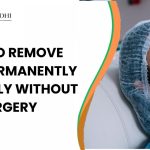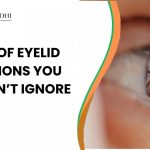|
Getting your Trinity Audio player ready...
|
Cataracts are a leading cause of visual impairment and blindness worldwide, especially among older adults. This condition occurs when the natural lens of the eye becomes cloudy, obstructing light from passing through and impairing vision. While cataracts are most commonly associated with aging, there are other risk factors and causes that can contribute to their development. Understanding these causes, along with steps for prevention, can help protect your vision and maintain eye health. Additionally, for those seeking treatment, options like cataract surgery in Gurgaon are available and highly effective in restoring vision.
Understanding Cataracts
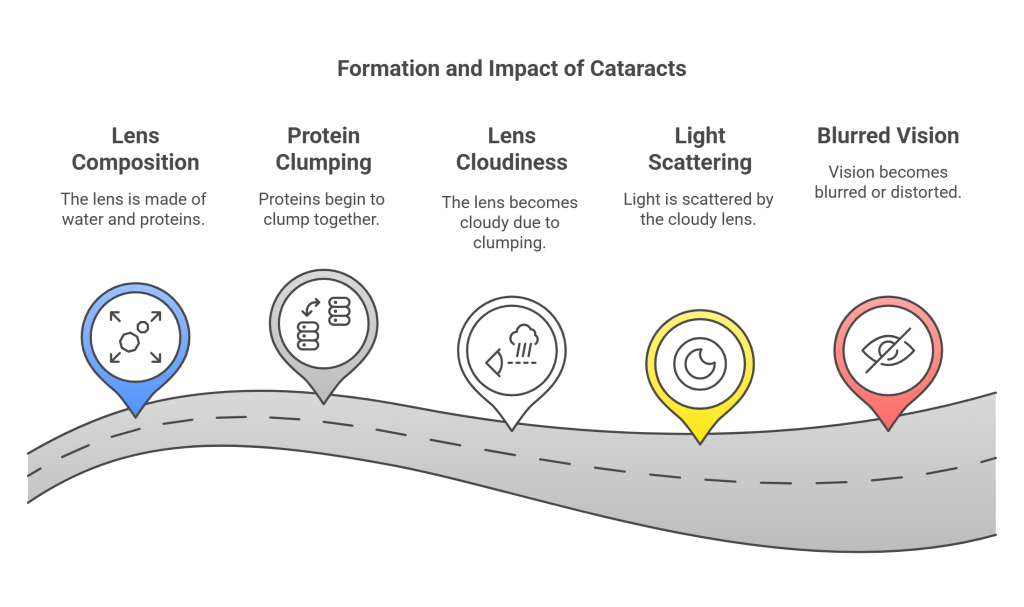
Cataracts develop when proteins in the eye’s lens begin to clump together, causing the lens to become cloudy. The lens, located behind the iris, focuses light onto the retina, enabling clear vision. When the lens becomes cloudy, it scatters light, leading to blurred or distorted vision.
How Cataracts Form
The lens of the eye is primarily composed of water and proteins arranged in a precise manner to allow light to pass through and focus properly. With age and exposure to certain risk factors, these proteins may denature and aggregate, causing cloudiness. Over time, this cloudiness worsens, making it increasingly difficult to see clearly.
Cataracts can develop in one or both eyes, though they do not spread from one eye to the other.
Major Causes of Cataracts
Aging
Age is the most significant cause of cataracts, accounting for the majority of cases. As people grow older, the proteins in the eye’s lens naturally degrade and clump together, leading to the formation of cataracts. By the age of 80, more than half of Americans have either developed cataracts or undergone cataract surgery, according to the National Eye Institute.
Ultraviolet Radiation
Long-term exposure to ultraviolet (UV) rays from the sun can damage the lens, accelerating the breakdown of proteins and leading to cataract formation. This is particularly prevalent in individuals who spend significant time outdoors without proper eye protection.
Health Conditions
Certain medical conditions can increase the risk of developing cataracts, including:
- Diabetes: High blood sugar levels can lead to changes in the eye’s lens, making cataracts more likely.
- Hypertension: High blood pressure may also contribute to lens clouding.
Lifestyle Choices
- Smoking: Smokers are up to three times more likely to develop cataracts than non-smokers. Smoking produces free radicals that can damage the eye’s lens.
- Excessive Alcohol Consumption: Regular heavy drinking can increase the risk of cataracts.
Medications
Prolonged use of corticosteroids and certain other drugs can increase the likelihood of cataract development. These medications can accelerate the denaturation of lens proteins, leading to cloudiness.
Eye Injuries and Trauma
Eye injuries, surgeries, or inflammation can lead to secondary cataracts. These traumatic cataracts may develop quickly or years after the injury.
Types of Cataracts
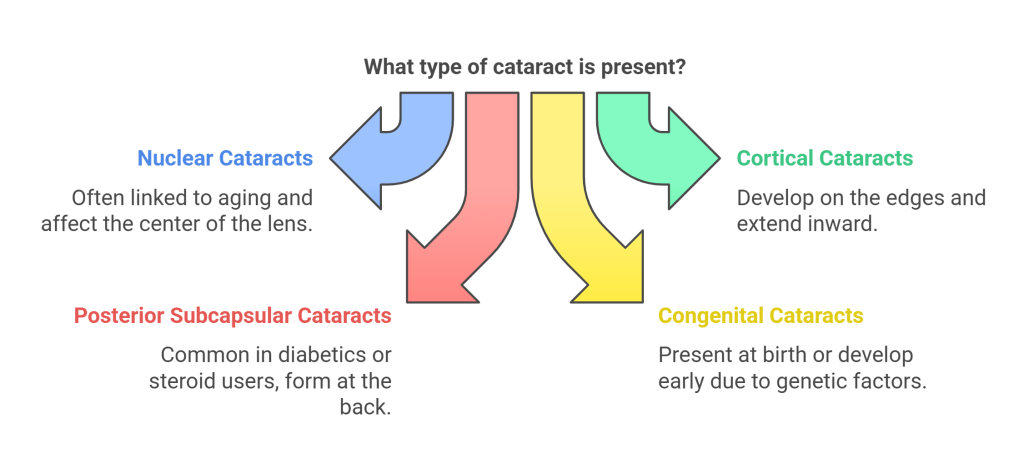
- Nuclear Cataracts: Affect the center of the lens and are often linked to aging.
- Cortical Cataracts: Develop on the edges of the lens and gradually extend inward.
- Posterior Subcapsular Cataracts: Form at the back of the lens and are more common in people with diabetes or those using steroids.
- Congenital Cataracts: Present at birth or develop in early childhood due to genetic factors or infections during pregnancy.
Symptoms of Cataracts
Cataracts often develop slowly, and symptoms may not be noticeable initially. As the condition progresses, symptoms may include:
- Blurred or dim vision.
- Difficulty seeing at night.
- Sensitivity to light and glare.
- Halos around lights.
- Fading or yellowing of colors.
- Double vision in one eye.
- Frequent changes in prescription glasses or contact lenses.
If you experience these symptoms, a comprehensive eye exam is crucial for an accurate diagnosis.
Risk Factors for Cataracts

Age and Genetics
Age is the primary risk factor, with cataracts becoming more common after the age of 40. Genetic predisposition also plays a role, with individuals having a family history of cataracts at greater risk.
Environmental and Lifestyle Factors
- Prolonged exposure to UV rays increases the risk of cataracts, particularly in those who live in sunny climates or work outdoors.
- Smoking and excessive alcohol consumption are significant contributors.
Systemic Health Conditions
Chronic conditions like diabetes and obesity elevate the risk of developing cataracts. These conditions can affect the metabolic processes of the eye, accelerating lens deterioration.
Preventive Measures
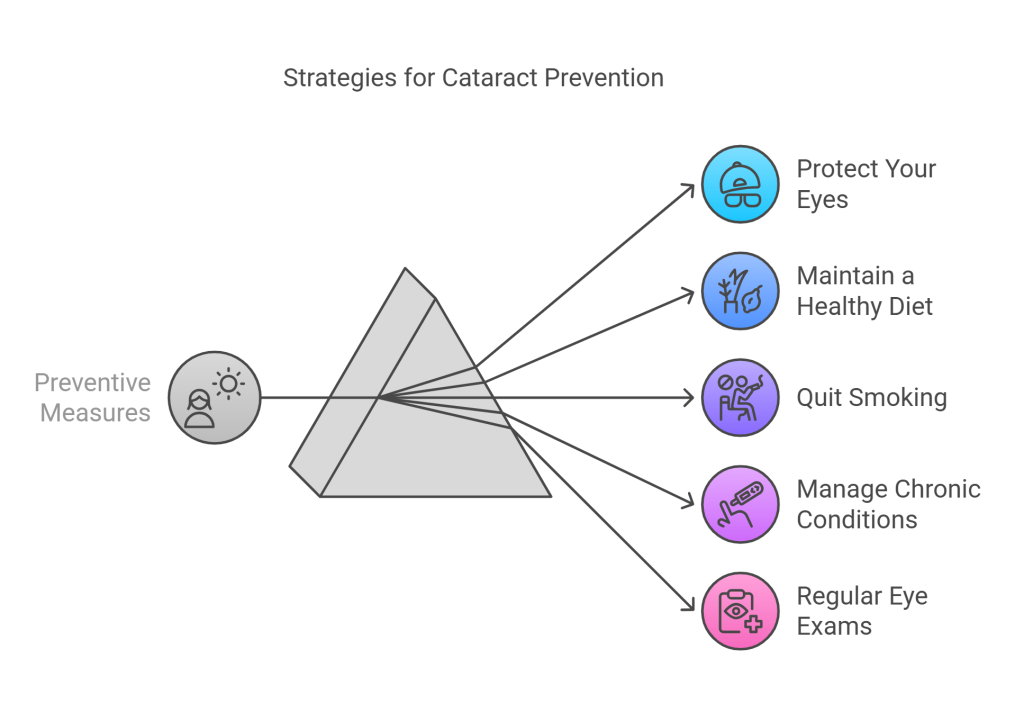
While cataracts cannot always be prevented, certain lifestyle changes and precautions can reduce the risk or delay their onset:
Protect Your Eyes
- Wear sunglasses that block 100% of UVA and UVB rays whenever you are outdoors.
- Use wide-brimmed hats for additional protection from the sun.
Maintain a Healthy Diet
- Consume foods rich in antioxidants, such as leafy greens, citrus fruits, and carrots. Antioxidants like vitamins C and E help combat oxidative stress in the eyes.
Quit Smoking
- Smoking cessation reduces the production of free radicals that damage the lens.
Manage Chronic Conditions
- Keep diabetes and other systemic conditions under control through medication, diet, and regular check-ups.
Regular Eye Exams
- Schedule regular eye exams, especially if you are over 40 or have risk factors for cataracts. Early detection can help manage the condition effectively.
Treatment Options for Cataracts
When cataracts interfere significantly with daily activities, surgery is often the only effective treatment. Cataract surgery is a safe and highly successful procedure that involves removing the clouded lens and replacing it with a clear artificial lens.
Cataract Surgery in Gurgaon
For residents of Gurgaon, cataract surgery in Gurgaon provides access to state-of-the-art facilities and experienced ophthalmologists. Advanced techniques, including phacoemulsification and laser-assisted cataract surgery, ensure quick recovery times and excellent visual outcomes. These procedures are typically performed on an outpatient basis, allowing patients to resume normal activities shortly after surgery.
Conclusion
Cataracts are a common age-related condition, but understanding their causes and risk factors can help in taking proactive steps to maintain eye health. While lifestyle changes such as wearing UV-protective sunglasses, eating a balanced diet, and quitting smoking can delay the onset of cataracts, regular eye exams remain crucial for early detection and management.
For those already experiencing significant vision impairment, modern treatment options like cataract surgery in Gurgaon offer an effective solution. By addressing cataracts promptly, you can restore clear vision and improve your quality of life. Always consult with an eye care professional to determine the best course of action for your specific needs.








